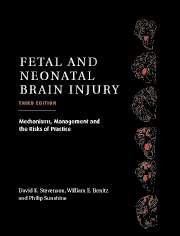Book contents
- Frontmatter
- Contents
- List of contributors
- Foreword
- Preface
- Part I Epidemiology, Pathophysiology, and Pathogenesis of Fetal and Neonatal Brain Injury
- Part II Pregnancy, Labor, and Delivery Complications Causing Brain Injury
- 9 Maternal diseases that affect fetal development
- 10 Antepartum evaluation of fetal well-being
- 11 Intrapartum evaluation of the fetus
- 12 Obstetrical conditions and practices that affect the fetus and newborn
- 13 Fetal and neonatal injury as a consequence of maternal substance abuse
- 14 Chorioamnionitis and its possible relation to subsequent cerebral palsy
- 15 Bacterial sepsis in the neonate
- 16 Neonatal bacterial meningitis
- 17 Neurological sequelae of congenital perinatal infection
- 18 Perinatal human immunodeficiency virus infection
- 19 Inborn errors of metabolism with features of hypoxic–ischemic encephalopathy
- Part III Diagnosis of the Infant with Asphyxia
- Part IV Specific Conditions Associated with Fetal and Neonatal Brain Injury
- Part V Management of the Depressed or Neurologically Dysfunctional Neonate
- Part VI Assessing the Outcome of the Asphyxiated Infant
- Index
- Plate section
15 - Bacterial sepsis in the neonate
from Part II - Pregnancy, Labor, and Delivery Complications Causing Brain Injury
Published online by Cambridge University Press: 10 November 2010
- Frontmatter
- Contents
- List of contributors
- Foreword
- Preface
- Part I Epidemiology, Pathophysiology, and Pathogenesis of Fetal and Neonatal Brain Injury
- Part II Pregnancy, Labor, and Delivery Complications Causing Brain Injury
- 9 Maternal diseases that affect fetal development
- 10 Antepartum evaluation of fetal well-being
- 11 Intrapartum evaluation of the fetus
- 12 Obstetrical conditions and practices that affect the fetus and newborn
- 13 Fetal and neonatal injury as a consequence of maternal substance abuse
- 14 Chorioamnionitis and its possible relation to subsequent cerebral palsy
- 15 Bacterial sepsis in the neonate
- 16 Neonatal bacterial meningitis
- 17 Neurological sequelae of congenital perinatal infection
- 18 Perinatal human immunodeficiency virus infection
- 19 Inborn errors of metabolism with features of hypoxic–ischemic encephalopathy
- Part III Diagnosis of the Infant with Asphyxia
- Part IV Specific Conditions Associated with Fetal and Neonatal Brain Injury
- Part V Management of the Depressed or Neurologically Dysfunctional Neonate
- Part VI Assessing the Outcome of the Asphyxiated Infant
- Index
- Plate section
Summary
Introduction
Bacterial sepsis of the neonate is defined as systemic signs of infection with bacteremia, occurring in the first 30 days of life. Meningitis accompanies sepsis in approximately one-quarter of cases of neonatal disease, but the two processes share a common etiology and pathogenesis. This chapter will cover only bacterial sepsis of the term infant; meningitis is covered elsewhere. Prematurity and residence in an intensive care unit are independent risk factors for bacterial sepsis that differ from sepsis in the term infant. In addition, the emphasis of this chapter will be on early-onset neonatal disease, with less of a concentration on late-onset sepsis.
Epidemiology
Although the ability to diagnose bacterial sepsis has improved, septicemia remains a frequent cause of neonatal morbidity and mortality. The first records of positive blood cultures were reported from Yale in 1928. Since this time there has been a changing prevalence of prominent bacterial organisms that cause sepsis in the neonate, requiring an ever-vigilant approach to this disease, and it is likely that changes will continue to occur with the use of intrapartum antibiotics.
Two distinct patterns of neonatal sepsis have been described, differentiated by time of disease onset, predominant organism, and associated risk factors. Early-onset disease is defined as occurring ≤7 days postnatally with a strong association with obstetrical complications or risk factors. Therefore, disease is caused by microorganisms that colonize the maternal genital tract.
- Type
- Chapter
- Information
- Fetal and Neonatal Brain InjuryMechanisms, Management and the Risks of Practice, pp. 314 - 332Publisher: Cambridge University PressPrint publication year: 2003



